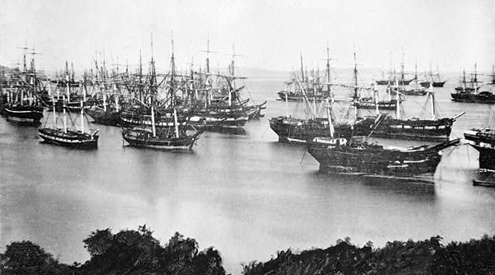By the beginning of June 1848 there were around 2,000 miners in the Sierra Nevada foothills above Sutter’s Mill. Most of these men had been in California when gold had been found, as the news was just reaching the far edges of the territory.
San Francisco practically emptied in the weeks after Sam Brannan ran through the streets yelling, “Gold! Gold! Gold from the American River!” By the middle of June, around 600 of the 800 residents of San Francisco had rushed to the mines, abandoning their homes and jobs.
Among the businesses that had to fold were the newspapers. The staff of The California Star left for the gold fields, and its last edition was June 14, 1848. The editor reported in his last issue that
A paper cannot be made by magic, and the labor of mechanism is as essential to its existence as to all other arts. . . . Our agencies are broken up, the methods of conveyance destroyed, and no one can define the locus in quo of his neighbor.
The alcalde (the local governor—like a mayor and magistrate combined) office in San Francisco also closed. In addition, crews of arriving ships deserted, leaving vacant vessels lining the harbor. Throughout the month of June more miners streamed into the gold fields from Monterey and Santa Cruz. As one historian wrote,
“One minute Monterey was the capital of a Mexican province called Alta California, and the next its lanes were deserted, the sounds of barking dogs echoing off the walls of empty adobe buildings. One minute the redwood forests up behind Santa Cruz were filled with the sound of saws biting into the redwood and the next the woods were quiet, trees left half-sawn and piles of bright pink redwood abandoned on the beaches. . . . What happens to a place when every able-bodied human up and leaves?”All That Glitters: An Argument in Support of Commemorating (and Lamenting) the California Gold Rush, by Sandy Lyon, Santa Cruz County History Journal, Issue 4, 1998. Lyon answered his own question:
“The immediate effects of the exodus of the able-bodied were a steep rise in the price of labor and a sharp drop in the real estate market. . . . Laborers who stayed behind could command wages of up to $15 per day, but gold fever often overtook them before they could complete any task. “The absence of a dependable supply of labor bedeviled the Monterey Bay Region for the next two decades. It was difficult for anyone infected with gold fever, even those who had no success in the mines, to return to the drudgery of day-to-day work.”The exodus from other locales to California began in JUne 1848 also. A Hawaiian newspaper reported on the gold discovery that month, and ships began to leave the islands (then known as the Sandwich Islands) with men seeking their fortune.
So James Marshall discovered gold at Sutter’s Mill in January 1848, and he and Johann Sutter tried to keep it secret. The news leaked slowly at first, and then the reports became an avalanche.
Wherever the word did get out, the lives and fortunes of individuals and of communities were changed forever.
When has your life been changed irrevocably? Were any of these changes due to significant public occurrences?

